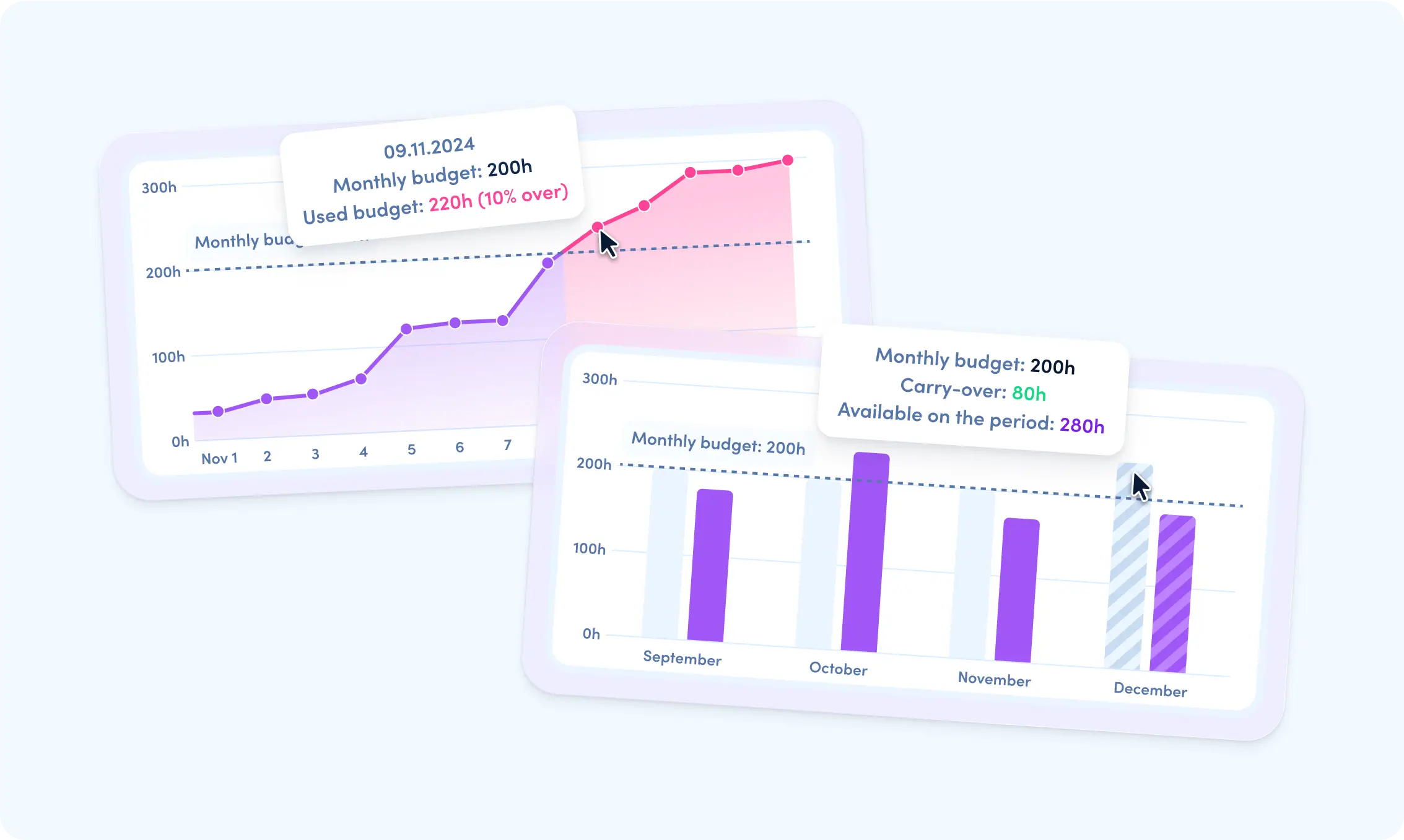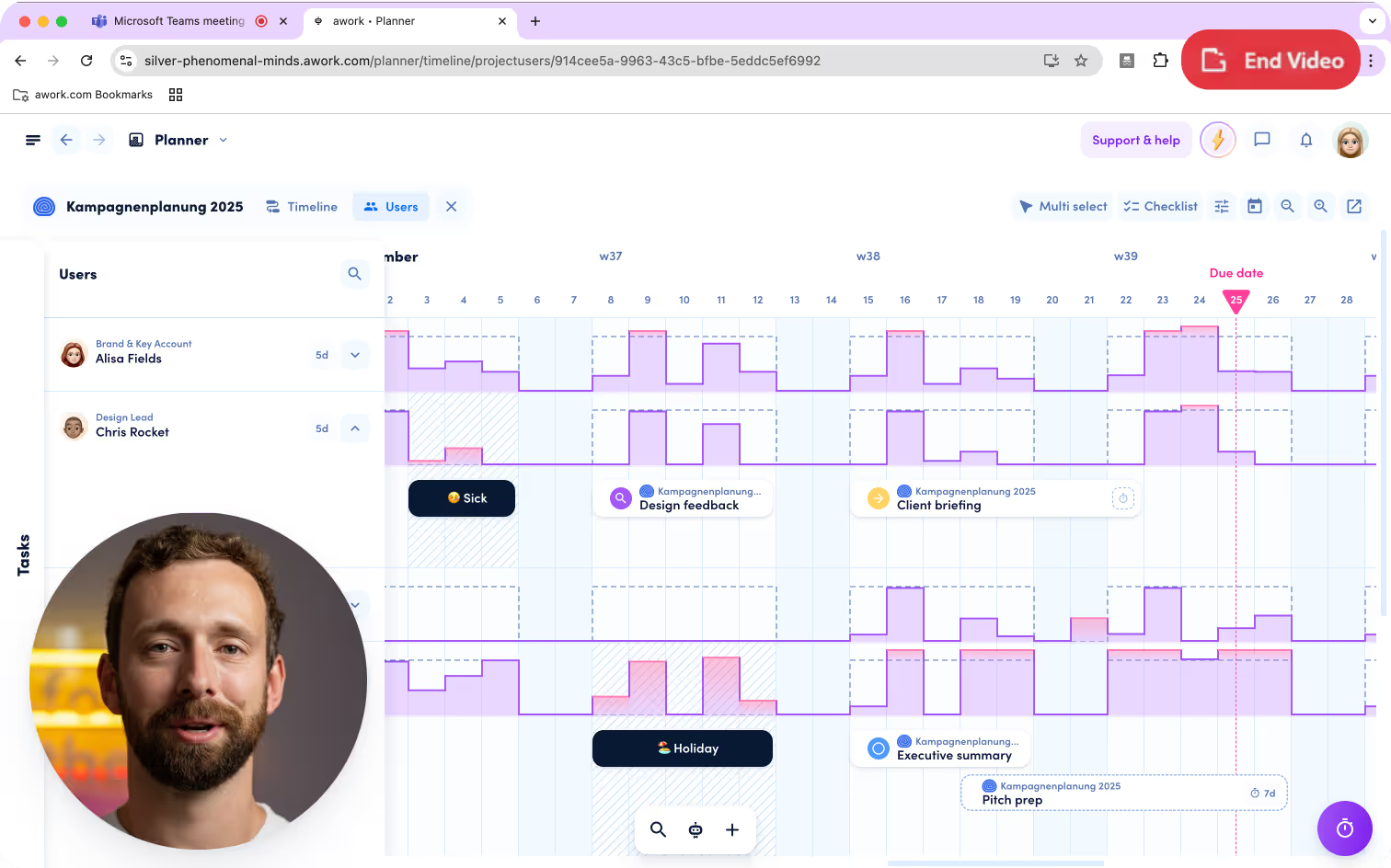





Before you can optimise, you need transparency. Many agencies lack an overview of how working time is distributed, between client projects, internal tasks, meetings or idle time.
How to do it:
This lays the foundation for informed decisions – e.g. when calculating quotes or allocating resources.
The more complicated time tracking is, the less often it is done. That's why it needs to be intuitive and seamlessly integrated into everyday work.
Make it intuitive:
This way, time tracking does not become a chore, but a natural part of everyday project work.
Not every hour is visible to the customer, but every hour counts for your profitability. If you don't make a clear distinction between internal and external, you lose track of margins and profitability.
Get clarity:
This allows you to see which projects are profitable – and where resources are being wasted.
It happens quickly, especially with ongoing projects or retainers: the budget is used up, but the team continues to work – without anyone noticing.
This can be avoided:
This ensures that you can react in time – and, if in doubt, make adjustments with the customer.
Time tracking is not a control instrument, but a strategic tool. With the right evaluations, you can precisely manage your agency business, from the quotation phase to billing.
Use your data:
This way, you not only work more transparently, but also more predictably and profitably.







































This is often because not all hours worked are actually recorded or correctly allocated. Many tasks, especially internal coordination, project management, or meetings, are not classified as billable, even though they are essential to the project.
Unclear processes and a lack of transparency in retainers also lead to working time being ‘wasted’ unnoticed.
As a rule, anything that is performed directly on behalf of a client or as part of a retainer is billable. This includes creative services, implementation, consulting, project management and sometimes communication.
Internal meetings, training, acquisition or administrative tasks are usually not billable. It is important to note that those who make a conscious distinction here can analyse better and calculate more accurately.
By integrating time tracking into everyday life as simply and flexibly as possible. The lower the barrier, the higher the recording rate.
It helps if time tracking is directly linked to tasks and projects, if different recording methods (timer, calendar, manual) are offered and if clear routines are established, e.g. daily or weekly updates.
The most important KPIs are:
These figures help to identify potential and make informed decisions.
Through regular analysis of time records. Typical time wasters include too many meetings, inefficient coordination, lack of priorities, or recurring manual tasks.
Once these are identified, processes can be adjusted, responsibilities clarified, or certain procedures automated.
By making time tracking easily accessible, sensibly integrated and as unobtrusive as possible. Regular reminders, transparent communication about the benefits (e.g. fair distribution of resources, better offers, less overtime) and integration into the project context are helpful. Time tracking should not be seen as a form of control, but as part of a healthy agency workflow.

I've been a project manager for over 14 years, and it feels like I've been searching for a proper digital solution for just as long. We now found that solution with awork.

The efficient workflows and project-related communications facilitated by awork are undoubtedly the best.

My team is truly excited about awork. We've tested other tools and were not as happy, but now we’ve found genuine relief and support for everyone.

We chose awork because it offers a wealth of features, outshining all the free project management tools while remaining highly flexible. Additionally, it was important to us that our tool of choice receives regular updates.

awork is incredibly intuitive to use. Everyone gets the hang of it right away and enjoys working with it.

Just had a chat with @awork’s support. That’s what I call customer-oriented work – very, very good. And the tool is just as capable!


Try it for free – no credit card required.
Or five? Get a super fast overview of awork and how it fits your team's needs - before even finishing your coffee, promised!
Try all features with your team - no strings attached. 🤞
Find out if awork is the right tool for you with a free 30‑min session with our experts: we'll give you a quick walkthrough and answer any questions you have.

For free – no strings attached

